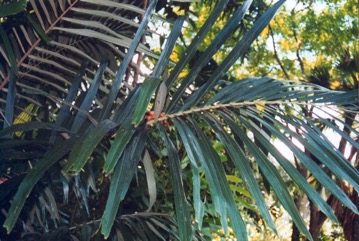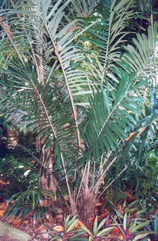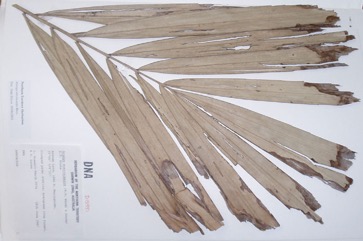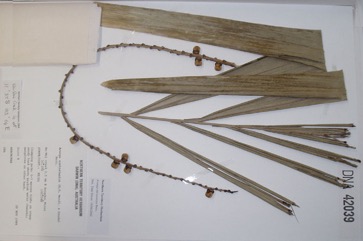Cabbage palm, Australian Sugar Palm

It is a tropical plant. It does best in well-composted, moist, well-drained soil. It needs a protected sunny position. It is damaged by drought and frost. It grows naturally in stony creek beds often in light shade. They are very sensitive to cold. It suits hardiness zones 11-12. In the Cairns Botanical gardens. In Townsville Anderson BG.
Also known as:
An-jardarrk, Palem aren australia
Synonyms
- Saguerus australasicus H. Wendl. & Drude
Edible Portion
- Bud, Cabbage, Palm heart
Where does Cabbage palm grow?
Found in: Asia, Australia, Indonesia, North America, SE Asia, United States
Notes: The flesh of the fruit contains calcium oxalate which can burn the skin. There are 17-20 Arenga species.
Growing Cabbage palm, Australian Sugar Palm
Cultivation: Plants are grown from seed. The seed germinate erratically taking 2-12 months or more. It can also be grown by suckers.
Nutrition Info
per 100g edible portion| Edible Part | Energy (kcal) | Protein (g) | Iron (mg) | Vitamin A (ug) | Vitamin c (mg) | Zinc (mg) | % Water |
|---|---|---|---|---|---|---|---|
| Palm heart | - | - | - | - | - | - |
Cabbage palm, Australian Sugar Palm Photos




References
Bodkin, F., 1991, Encyclopedia Botanica. Cornstalk publishing, p 99
Checklist of NT Vascular Plant Species. January 2003.
Cooper, W. and Cooper, W., 2004, Fruits of the Australian Tropical Rainforest. Nokomis Editions, Victoria, Australia. p 68
Cronin, L., 1989, The Concise Australian Flora. Reed. p 217
Cronin, L., 2000, Australian Palms, Ferns, Cycads and Pandans. Cronin Publications. p 40
Cundall, P., (ed.), 2004, Gardening Australia: flora: the gardener's bible. ABC Books. p 181
Elliot, W.R., & Jones, D.L., 1982, Encyclopedia of Australian Plants suitable for cultivation. Vol 2. Lothian. p 225
Etherington, K., & Imwold, D., (Eds), 2001, Botanica's Trees & Shrubs. The illustrated A-Z of over 8500 trees and shrubs. Random House, Australia. p 104
Hibbert, M., 2002, The Aussie Plant Finder 2002, Florilegium. p 32
Jackes, B.R., 2001, Plants of the Tropics. Rainforest to Heath. An Identification Guide. James Cook University. p 42
Jones D.L, 1986, Ornamental Rainforest Plants in Australia, Reed Books, p 326
Jones, D.L., 1994, Palms throughout the World. Smithtonian Institution, Washington. p 131
Jones, D.L., 2000, Palms of Australia 3rd edition. Reed/New Holland. p 78
Price, S.H. & J.L., Wild Food, Medicine and useful plants of the Wet tropics. Kwik Kopy, Cairns. p 6
Riffle, R.L. & Craft, P., 2003, An Encyclopedia of Cultivated Palms. Timber Press. p 33, 257
Smith, N. M., 1991, Ethnobotanical Field Notes from the Northern Territory, Australia, J. Adelaide Bot. Gard. 14(1): 1-65
Sukarya, D. G., (Ed.) 2013, 3,500 Plant Species of the Botanic Gardens of Indonesia. LIPI p 752
Townsend, K., 1994, Across the Top. Gardening with Australian Plants in the tropics. Society for Growing Australian Plants, Townsville Branch Inc. p 87
Tucker, R., 1988, The Palms of Subequatorial Queensland. Palm and Cycad Society of Australia, Milton, Queensland. p 44
Yunupinu Banjgul, Laklak Yunupinu-Marika, et al. 1995, Rirratjinu Ethnobotany: Aboriginal Plant Use from Yirrkala, Arnhem Land, Australia. Northern Territory Botanical Bulletin No 21. Parks and Wildlife Commission of the Northern Territory. p 19